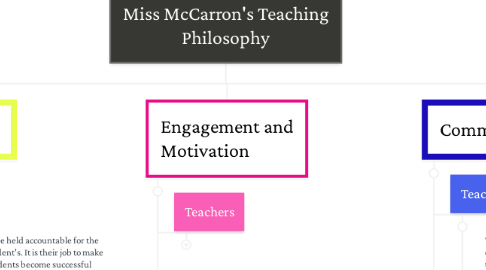
1. Accountability
1.1. Teachers
1.1.1. Teachers need to be held accountable for the future of their student's. It is their job to make sure that their students become successful members of the school, as well as in the community.
1.1.2. Jacob Kounin, an educational psychologist from Wayne State University, studied how classroom management affected student’s behaviors (Spaulding & vandeVeit, 2018). He coined the term withitness, which means that the teacher is aware of what is going on in the classroom at all times. He also believed that the teacher should hold the student’s accountable for their own actions and for their education.
1.2. Students
1.2.1. Students also must be held accountable for their actions in the classroom. They should be able to complete daily assignments, abide by classroom rules, and make positive decisions in their relationships with other class members.
1.2.2. Alfie Kohn, emphasizes the importance of building a relationship between teacher and student. He also focuses on the relationships between the students in the classroom. He believes in partnerships and getting to know each other activities such as interviews, partner sharing, and point of view activities.
2. Engagement and Motivation
2.1. Teachers
2.1.1. Employee
2.1.2. Employee
2.2. Teachers need to be aware of the engagement of their students. Before beginning a lesson or explaining directions, teachers should gain the full attention of their students. This way, the students are ready to learn and begin the lesson.
2.3. Kounin wanted the teacher to gain each student’s attention before beginning the lesson to make sure that the children were on task and focused. By gaining the full attention of the students, the teacher would reduce unwanted behavior in the classroom (Charles, 2008).
2.4. Students
2.4.1. Student motivation is key when planning lessons for the classroom. If the children are not motivated, it is rare that they will retain the information being provided. By adhering to all of the multiple intelligences and giving the student's choice, it is more likely that the students will be involved during instruction.
2.4.2. Alfie Kohn (Charles, 2008) believes in a least restrictive environment, flexibility, as well as student involvement. He encourages students to have a voice in their classroom and should present restrictions in a positive manner, rather than giving out orders.
3. Communication
3.1. Teachers
3.1.1. Teachers must be aware of how they communicate directions, rules and discipline to their students. Children need directions and rules in small phrases so that they can remember. Teachers must also use positivity when communication with their students so that they will be more likely to participate.
3.1.2. Hair Ginot believed in discipline through congruent communication in the classroom. Ginott was an educator himself and later went to school to study psychology at Adelphi University (Charles, 2008). Teachers must be careful as to why and how they say things to their students.
3.2. Students
3.2.1. A healthy and positive relationship between teacher and student is key to the learning process. Students should feel safe and comfortable in the classroom so that they are able to share ideas and ask questions when supports are needed.
3.2.2. From past field experiences, I have learned that it is easier to form relationships with the teacher can find positive things about each student that overlook a negative behavior. I think that keeping a positive rapport between teacher and students is a way to create a productive and safe learning environment.
